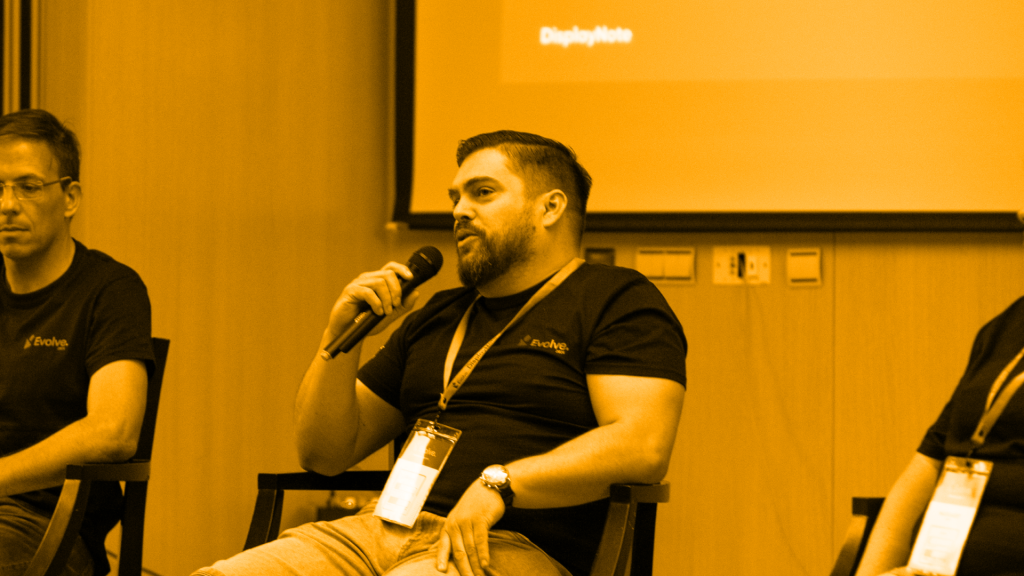
Tips to make your classes more collaborative.
Collaborative learning is a method of teaching and learning in which students team together to explore a significant question, or create a meaningful project.
However, collaboration shouldn’t stop with the students working together – teachers and students should work together during lessons, instead of working as two separate entities. Speaking at students, without requiring any contribution from them, will only disengage them. They are disinterested, tired, distracted – their minds wander.
So we put together these top tips to help make your lessons more collaborative with DisplayNote.

1. A little less conversation, a little more action
Gone are the days where the teacher stands at the top of the classroom, beside a blackboard, and talks at students. Classes need to be interactive – no more chalk and talk. Nowadays there needs to be more of a 2-way conversation between teachers and students. Turning lessons into more of a discussion means students have an active role in the lesson, as opposed to passive one. Sharing teachers’ screen down to students’ devices, and allowing students to contribute to the content being shared, annotating over it, adding thoughts and comments – this all ensures they are contributing to the lesson, and therefore are more engaged.
2. Self-learning
There’s always going to be an aspect of self-learning required during lessons. Individual students have different ways of learning; some are visually stimulated, some text, some aural. Since students all have their own individual methods of learning, they need to make their own notes, sketches, annotations alongside the teacher’s content. Sharing content down to students’ devices, and allowing them to make their own personal notes and annotations on it, helps promote self-learning. Using a digital collaborative tool such as Displaynote, is much better than a pen and paper, because students’ notes will have context – their notes will accompany the teacher’s slides. It also means that students can save the new version of the content down to their device, and refer back to it when studying. No more lost paper notes!
3. Any device, anywhere
Sometimes Mother Nature takes control of the environment, and depending on the weather, some students may not be able to physically make it to the school building. Elements such as high wind, snow, rain could leave students with no method to get into school. But in today’s world, schools make better use of technology. They have hardware and software that can facilitate remote learning. Especially software that shares the teacher’s screen down to student devices. Allowing students to join a lesson from any device, anywhere means they don’t miss out on their learning if they can’t physically make it into school, and can still contribute and collaborate if they aren’t in the class at that time.
4. Understanding is deeper than knowledge
Thinking back to when I was in school, there were a couple of topics that I just memorised, and recalled the information in exams – but I didn’t actually delve into the topic – understand why it was how it was, or why I was memorising the things I was memorising. William Arthur Ward was right when he said “learning is more than absorbing facts – it is acquiring understanding”. It’s crucial that as a teacher, you can gauge whether or not your students fully understand a topic, before moving on to the next one. Things like live polls, or interactive voting can help with this. These solutions allow teachers to pose live questions to the students, and they can answer from their devices. From these poll results, teachers can determine whether students understand the topic or not. If the majority of students don’t understand it, the teacher has this insight to allow he or she to spend more time on this topic, and plan accordingly.
There’s an interesting article on The Guardian which poses the question “Is technology and the internet reducing pupils’ attention spans?”
It argues that the internet and digital gadgets are making it harder for us to concentrate.
However the fact is, technology isn’t going away – more and more children and teens will spend more of their time using technology. It’s pointless for schools to try and go against this. The most beneficial approach for schools is to integrate technology into their lessons, making their lessons more engaging and interactive.
With students’ attention spans continually dwindling, schools need to come up with imaginative and innovative ways to carry out lessons. Dianaimh Ward, music teacher at the Academy School in Warrington, states that if you don’t have an engaging lesson, you don’t have a lesson.
The DisplayNote solution helps teachers to make their lessons more interactive. It allows students to connect and contribute to the content and collaborate with each other from their own devices.
Want to stay in the loop?
Keep up-to-date with everything DisplayNote – including new releases, job openings, and customer giveaways.
Don’t worry, we’ll not spam you and we’ll never share your email with anyone






